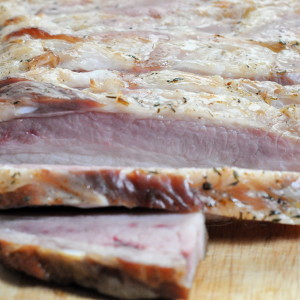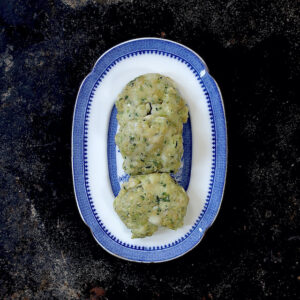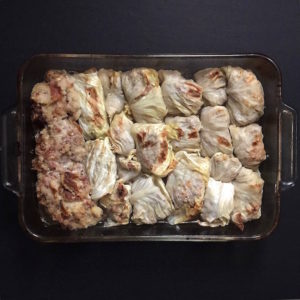Tea-Smoked Salmon
Cookbooks are full of suggestions for the smokerless (nonsmokers?). These range from relatively low-tech tinfoil and rice setups to some outright alarming suggestions. I have a book whose directions for a home-built smoker include words like “hinges,” “flexible aluminium tubing,” and “battens.” When you’re to a word like “battens,” I say buy the damned smoker already.
Don’t misunderstand: I’d love a smoker. But we sort of need other things right now. Like a roof. So a smoker has to wait.
I could tell you financial lack finally motivated me to turn my wok into a smoker, but I’d be lying. The truth is more prosaic. While flipping through Yotam Ottolenghi’s Plenty More, I happened on a recipe for Smoked Beets With Yogurt And Caramelized Macademias. I will never cook this, because I dislike beets. It was Ottolenghi’s method that got my attention: he lines a pan or wok with foil, adds rice to the pan, then shrouds the lid in foil and smokes at high heat. It was the wrapping the lid business that interested me, as I found it reassuring. Prior to this, the idea of filling my wok with potentially flammable items and cranking up the heat was a little scary. I can’t imagine why.
Later that same evening–this was Sunday–I was reading Diana Henry’s The Gastropub Cookbook: A Second Helping, which is an amazing journey through the United Kingdom via some beautiful pubs. At an eight-table place called The Wellington Arms, Simon Page and Jason King farm, make jams, chutneys, and prepare a Tea Smoked Brown Trout.
Somehow happening on two tea-smoked recipes motivated me. Monday morning found me ordering Alaskan salmon at the market, then buying some loose Chinese green tea. I drove home, trying not to get too nervous.
For years I was a timid fish cook. Some of that anxiety lingers to this day. Here I was with $20 of beautiful fish, about to embark on an entirely new cooking process. If I messed up, 24 ounces of Alaskan salmon, fish that aren’t doing so well thanks to human stewardship, or lack thereof, would be ruined. And that weighed on me far more than any financial loss.
Once home I wondered what I’d gotten myself into. How long should I smoke the fish? What would I smoke them in? How much tea? How much rice?
Back to the books.
Ottolenghi, who is smoking rock-hard raw beets, takes eight minutes before finishing them in a hot oven. Jason King of the Wellington Arms smokes brown trout for two minutes, then finishes them in a 350F oven. For good measure, I remembered David Tanis had a tea smoking recipe in one of his books. Sure enough, in Heart Of The Artichoke there’s a recipe set entitled “The Flavor of Smoke.” Tanis simmers chicken legs in scallion broth, then smokes them much as King does, for two minutes. I had my answer.
Next question: smoking vessel. David Tanis suggests a Dutch oven or roasting pan with a lid. More practically, in The Gastropub Cookbook: A Second Helping, Diana Henry says to use “an old roasting tin.” Ottolenghi: “big wok.” I went the big wok route, and was glad I did. Tea smoking isn’t messy, but it does blacken the pot surface. More on this later.
Party time. I tore off two pieces of foil, each about three feet long, and lined the wok with them, leaving a generous overhang on all four sides of the wok.
Winging it, I decided on equal amounts of rice and tea, using a cup each. The tea was Chinese green, the rice, inexpensive Japanese white.

This smacked me into the next hurdle: a rack. Don’t you love when recipes blithely assume you have equipment? Place the fish atop….yeah, right. The same cookbooks offering instructions for jury-rigged smokers tell you chopsticks are good makeshift racks. My chopsticks, which were a gift, are delicately handpainted with scenes of geisha, dragons, and elegant Japanese couples. Clearly they were never meant to double as smoker racks.
Insufficiency is the mother of invention. Bamboo skewers make excellent makeshift racks. Not such pretty pictures. But good racks.
I mixed the rice and tea with my fingers and laid in the skewers, which I’d dampened with water.

Meet the star of the show.

You can see why I was nervous. Also why I sliced the fish in half before placing it upon the makeshift rack.
Plunking the lid on the wok, I brought the foil up and around it, wrapping the whole package tightly. Checking for any openings between the pan and lid, I added more foil to ensure a complete seal.Then I cranked the burner on high, gnawed a piece of cold pizza and waited for something to happen.
This is the hardest part of the recipe, asking as it does for the cook trust the her senses. After a few minutes the tea/rice combination started crackling. The tea smelled strongly tobacco-like. A few wisps of smoke escaped the wok. I counted two minutes, then turned off the heat.
Unsure how much smoke I’d be releasing once the lid came off, I picked up the wok and hurried to the bedroom, where we have French doors that open to a patio. Fortunately, John was sitting outside. “John,” I yelled out the window, “Open the door so I can come out!”
So this part could’ve been better planned.
Safely outside, I set the wok on our scrubby “lawn,” carefully peeled back the foil, and removed the lid. A modest amount of smoke blew off the reveal these beauties:

I confess to the sin of inordinate pride. As it was too early for a drink, I patted myself on the back (we of the EDS tribe are able to do this) and performed a victory limp around the yard.
Then I put the fish in the fridge and cleaned the kitchen, which looked like a tea-filled foil balloon had exploded in it. Know that the fish can rest as long as overnight before the final sauté. The fancy-schmancy part of the recipe is over. The final cooking is easy.
Before we launch into the recipe, a few practical words on tea smoking….
This recipe is for those of you who, like me, are smokerless. Know that the permutations for homemade smokers are many, as are smoking mediums–all manner of teas, sugars, rices, even wood chips or shavings. This is only one.
Please do not use your treasured French cocotte for this recipe. If you have a lidded wok, use that. Otherwise, an old lidded roasting pan or pot you don’t care about would be good. If you don’t have such an item but want to attempt this recipe, check out your local resale or Goodwill shop. Or buy a wok: they’re cheap. Tea-Smoking blackens the bottoms of pans. Please don’t send me angry emails or comments about ruined pots. You’ve been warned.
About smoke: Provided the wok is well wrapped in foil, this won’t smoke wildly. Nevertheless, to avoid setting off your smoke detectors, open your windows. If your oven has an exhaust fan, you might want to turn it on. By all means, once you’re finished smoking, open the pan outdoors if possible. If you live in an apartment tower on the 25th floor, stand beside an open window. This recipe doesn’t create billows of smoke or anything, but turning off smoke detectors is a hassle.
Now, why you’re bothering to begin with: because it’s wonderful. Tea-smoked salmon tastes much lighter than store-bought smoked salmon (not that I object to smoked salmon of any kind). Tea-smoking doesn’t cook the fish through. Instead, it gives a light, lovely, delicate taste, utterly unlike anything I’d tasted before. That’s what makes it so special.
Plus there is something about home-smoking, curing, or any home preserving process that gives an extra little…filip. No, you don’t need to. It’s totally unnecessary in the grand scheme of things. It’s just fun. And given life lately, we’ll take our fun where we can get it.
I can’t see why you’d need to restrict tea-smoking to salmon, or, for that matter, fish. I’d try this with chicken breasts or even plain cheese.
While this recipe is my own, invaluable help in creating it came from Yotam Ottolenghi’s Plenty More, Diana Henry’s The Gastropub Cookbook: A Second Helping–and congratulations to Ms. Henry on her James Beard Award for A Bird In The Hand–and David Tanis’s Heart Of The Artichoke. Credit also goes to Chef Jason King of The Wellington Arms, for his tea-smoked brown trout recipe.

Tea-Smoked Salmon
Prep time: 2 minutes to smoke the salmon. Between 5-10 minutes to sauté it, depending on size of your fillets
yield: 2-3 servings, easily scaled upward
For smoking the fish:
One 1 1/2 pound salmon or other firm, meaty fish fillet, ideally sustainably raised (I used 24 ounces of Alaskan salmon)
1 cup loose green tea
1 cup white rice
To sauté the fish:
1 tablespoon unsalted butter
1 tablespoon best olive oil
1/4-1/2 cup white wine or Vermouth (depending on your pan size)
1 large garlic clove, peeled and minced
1 teaspoon capers, rinsed if salt-packed, minced
Generous squeeze fresh lemon juice: I used half of a large Meyer lemon
salt and pepper (be mindful that capers are salty)
It’s wise to open windows and turn on your oven fan, if you have one, to avoid setting off the smoke detector. This recipe doesn’t cause billowing smoke, but some detectors are quite sensitive.
Please see discussion of cooking vessels, above. Do not use your nicest enamel-lined cooking pots to tea-smoke, as the bottoms may be permanently blackened. Instead, use a lidded wok or old roasting lidded pan you don’t care about.
You will need tinfoil, a large lidded wok or old pan, and either a rack or skewers to rest the fish on.
Set the wok on the largest oven burner. Lay two 3-foot lengths of tinfoil crosswise in the bottom of the wok. You’ll be using the overhang to wrap your lid in a few minutes.
Pour the tea and rice into the bottom of the wok and mix a bit with your clean fingers or a spoon. Place a rack on top, or set up skewers (pictured above). You want the fish sitting above the tea/rice mixture. My skewers are bamboo, so I dampened them first.
Now lay your fish, skin side down, on the rack/skewers. If your fillet is large, you may need to slice the fish into two. Don’t crowd the wok.
Put the lid on. Bring up foil, complete encasing lid. Check to see if there are any gaps; seal with additional foil if necessary. Turn the burner to highest setting.
Don’t go away. Stay right there. Within 2-3 minutes, you will hear the tea/rice start crackling and smell the tea. You may see wisps of smoke escaping your wok. Don’t worry–these signs are quite evident provided you aren’t texting or freaking out over election news. Once you hear/smell/see, time 2 minutes, then turn off the burner.
If you can open the lid outdoors, please do. Otherwise, lift the lid by an open window.
At this point, the fish can be refrigerated 24 hours before the final sauté.
To finish cooking:
In a frying pan large enough to hold the fish, melt the butter with the olive oil over low heat. Add just enough wine to create a pan sauce; my pan is 14 inches across, so I needed the full 1/2 cup. Add the garlic and bring up the heat to medium. Cook for about two minutes, allowing the garlic to soften but not brown. If it browns, turn the heat down.
Add the salmon, skin side down. Add the capers. Squeeze the lemon juice over all.
Add salt, mindful that capers are salty. Add the pepper.
Cooking time will depend on the thickness and cut of your salmon. It also depends on personal taste: some people prefer their fish cooked more than we do. As mine was thicker at one end, and my burner has hot spots, I carefully moved the fish around the pan. Ultimately I gave it about 4 minutes a side, but you can see from the photographs that it’s pretty raw at the center. I trust our fishmonger. Cook longer if you like.
We ate this with fresh fava beans and English peas–recipe to come, hopefully next week.





